TIPS FOR RIDERS:
MOTORCYCLE ACCIDENTS
Motorcycle riders continue to be overrepresented among traffic fatalities, largely due to a lack of visibility to drivers of passenger vehicles. When motorcyclists crash, they also lack the protective shell of an enclosed vehicle, leaving them more vulnerable to injuries and death.
Since the turn of the century, motorcyclist deaths as a percentage of all motor vehicle crash deaths have doubled, and in 2022, motorcyclists were 22 times more likely than passenger vehicle occupants to die in a crash. During that year, 6,218 motorcyclists were killed in crashes in the United States. According to the National Highway Traffic Safety Administration, this was the highest number of motorcyclist fatalities since at least 1975.
To combat rising motorcyclist fatalities, NHTSA urged drivers and motorcyclists to share the road, remain alert and visible, and drive sober. Even though other vehicles are often involved in motorcycle crashes, accident prevention starts with riders—specifically, by taking precautions when riding and staying informed on crash statistics. By raising motorists’ awareness, everyone will be safer on the road.
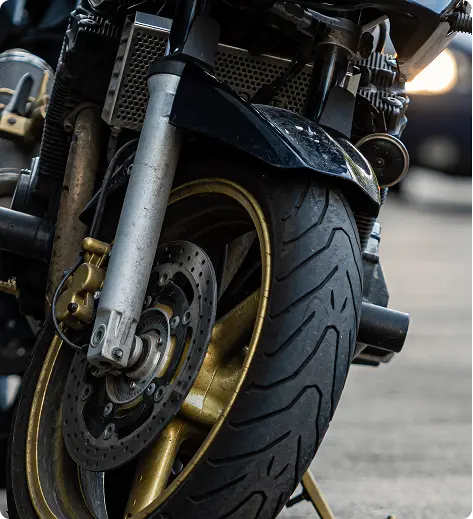
Factors Affecting Motorcycle Crashes
Even though motorcycles make up only 3 percent of registered vehicles and 0.7 percent of vehicle miles traveled in the country, motorcyclists accounted for 15 percent of all traffic fatalities and 3.5 percent of all traffic crash injuries in 2022. Over the last decade, motorcyclist deaths increased by 32 percent, and fatality rates per vehicle miles driven rose by 13 percent. Despite an increase in fatality rates, the number of registered motorcycles nationwide has increased significantly over the past ten years.
A number of factors play into the country’s increased motorcycle fatality numbers, including the rider’s gender. The vast majority of motorcyclist deaths in 2022 were men, almost all of whom were drivers, not passengers. More than half of the female motorcyclists who died in crashes in 2022 were passengers, and their deaths represented 91 percent of all motorcycle passenger deaths. Additional factors that affect motorcycle crashes include the following.
Time of Day
In 2022, half of all motorcyclist fatalities occurred during the day when visibility was at its highest. However, 45 percent of motorcyclist deaths occurred on weekends, and those deaths were considerably more likely to occur after 6 p.m. than weekday fatalities. Time of year also plays a role in fatalities—in 2022, 60 percent of motorcyclist deaths occurred between May and September. Fatalities peaked in June and were the lowest in January.
Weather
Even though harsh weather conditions make it more difficult to keep motorcycles stable and be seen by other drivers, the vast majority of motorcyclist fatalities in 2022 occurred in good weather.
Location
Two-thirds of motorcyclist fatalities in 2022 occurred on urban roads.
Crash Type
Most motorcycle crashes that ended in death in 2022 involved two vehicles, while single-vehicle crashes made up 38 percent of fatalities. Only 7 percent of motorcyclist fatalities occurred in crashes involving three or more vehicles.
Bike Power
In general, motorcycles with smaller engines lead to significantly fewer deaths. The engine sizes of motorcycles whose drivers were killed in crashes have increased dramatically, and over a third of riders killed in 2022 had engines over 1400cc. In 2000, only 9 percent of riders had engines this large.
Age of Rider
In the 1970s, around 80 percent of motorcyclist deaths involved riders under age 29. However, the tides have turned on that trend. In 2022, only a quarter of motorcyclist deaths involved riders under age 29, while 22 percent of fatalities were riders in their 30s, 17 percent were riders in their 40s, and over a third of motorcyclist fatalities were riders over age 50.
License and Training
Safe motorcycling takes balance, coordination, and good judgment. While all states require a motorcycle license endorsement to supplement a regular driver’s license, not all require full motorcycle education courses to ensure riders have the correct instruction and experience to ride safely. According to the Insurance Institute for Highway Safety, the percentage of riders in fatal crashes who did not have a valid motorcycle license has increased by 8 percent since 2013. Of the motorcycle operators involved in fatal crashes in 2022, 35 percent were riding without a valid motorcycle license.
Motorcycle Traffic Death Overview, 2022
Rural / Urban

Urban (66%)
Rural (33%)
Weather

Clear/Cloud (84.38%)
Rain (2.07%)
Fog (0.48%)
Other/Unknown (13.06%)
Time of Day

Daytime (50.1%)
Nighttime (49.21%)
Unknown (0.68%)
Crash Type

Single-vehicle (37.94%)
Two-vehicle (54.74%)
Three or more vehicles (2.32%)
Helmet Use

Helmeted (60.26%)
Unhelmeted (36.09%)
Unknown (3.65%)
Alcohol-Impaired Drivers

Impaired (BAC=0.08+ g/dL) (28.48%)
Not alcohol Impaired (71.52%)
Motorcyclist deaths and death rates, 2007 - 2022

Motorcyclist injury and injury rates, 2007 - 2022
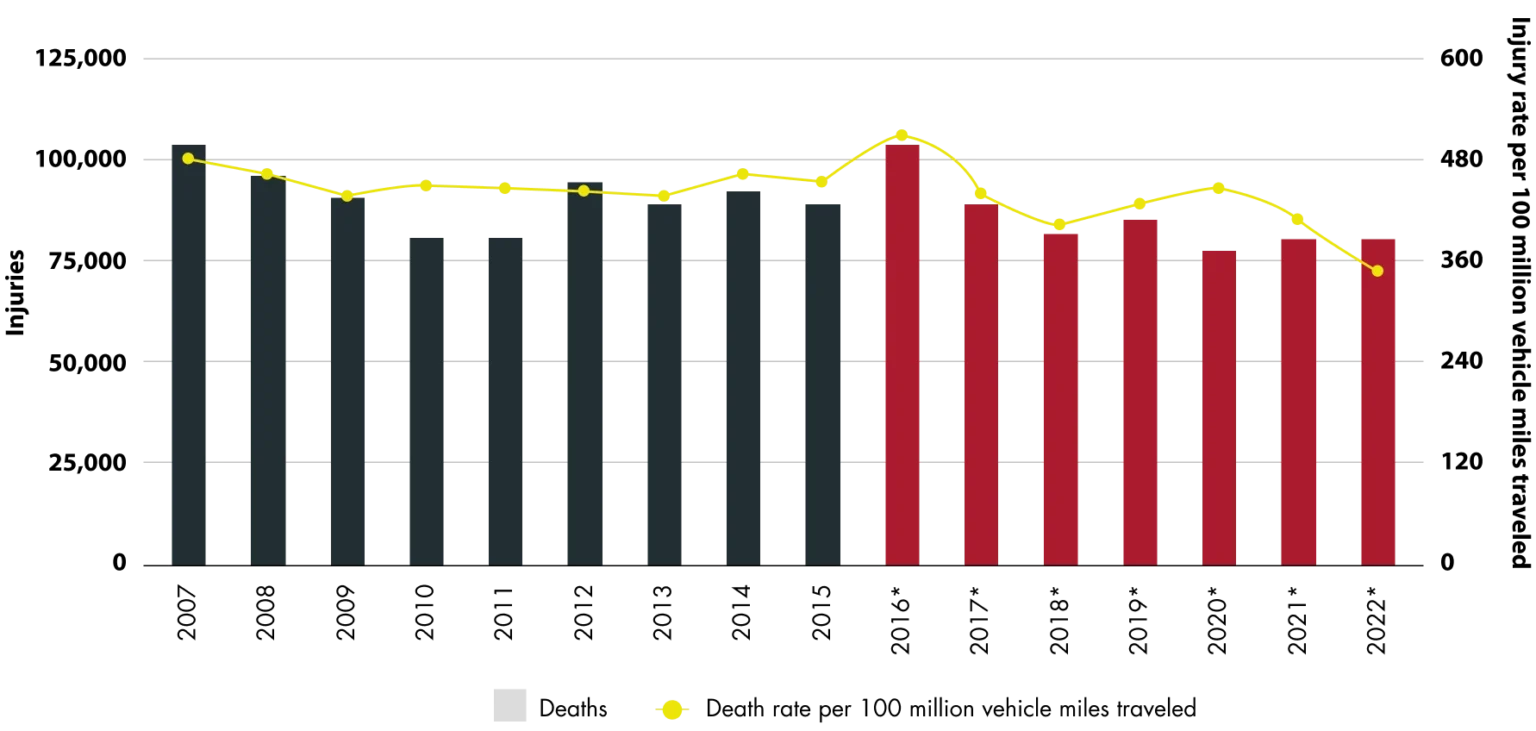
Passenger vehicle occupant deaths and motorcyclist deaths, 1975-2022
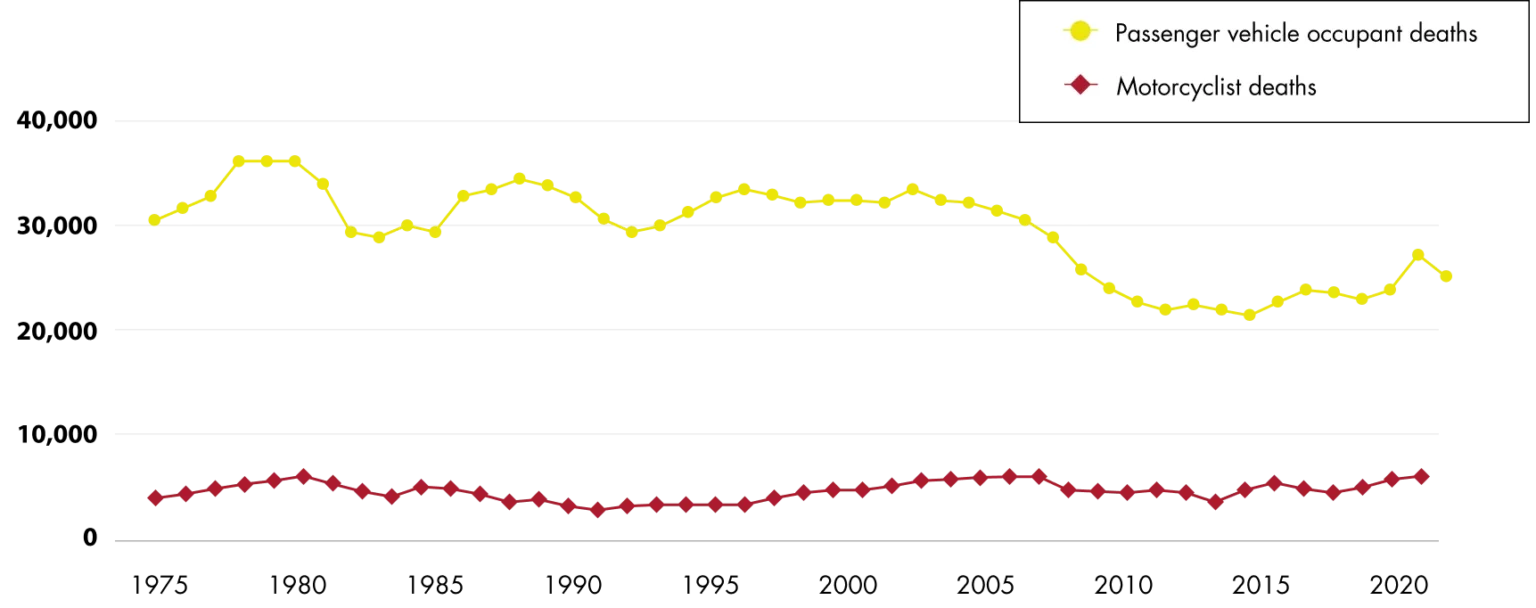
Percentage of motorcyclist deaths by age, 1975-2022

In 2022, 62% of fatally injured motorcycle drivers were helmeted. Helmet use was lower, at 42%, for people killed as passengers on motorcycles.
| Helmet | No Helmet | Total | |
|---|---|---|---|
| Number % | Number % | Number % | |
| Driver | 3,676 - 62% | 2,038 - 34% | 5,935 - 100% |
| Passenger | 118 - 42% | 147 - 52% | 283 - 100% |
| Total | 3,798 - 61% | 2,185 - 35% | 6,222 - 100% |
| *Total includes other and/or unknowns | |||
Percentage of motorcycle driver deaths by motorcycle engine size, 1985-2022
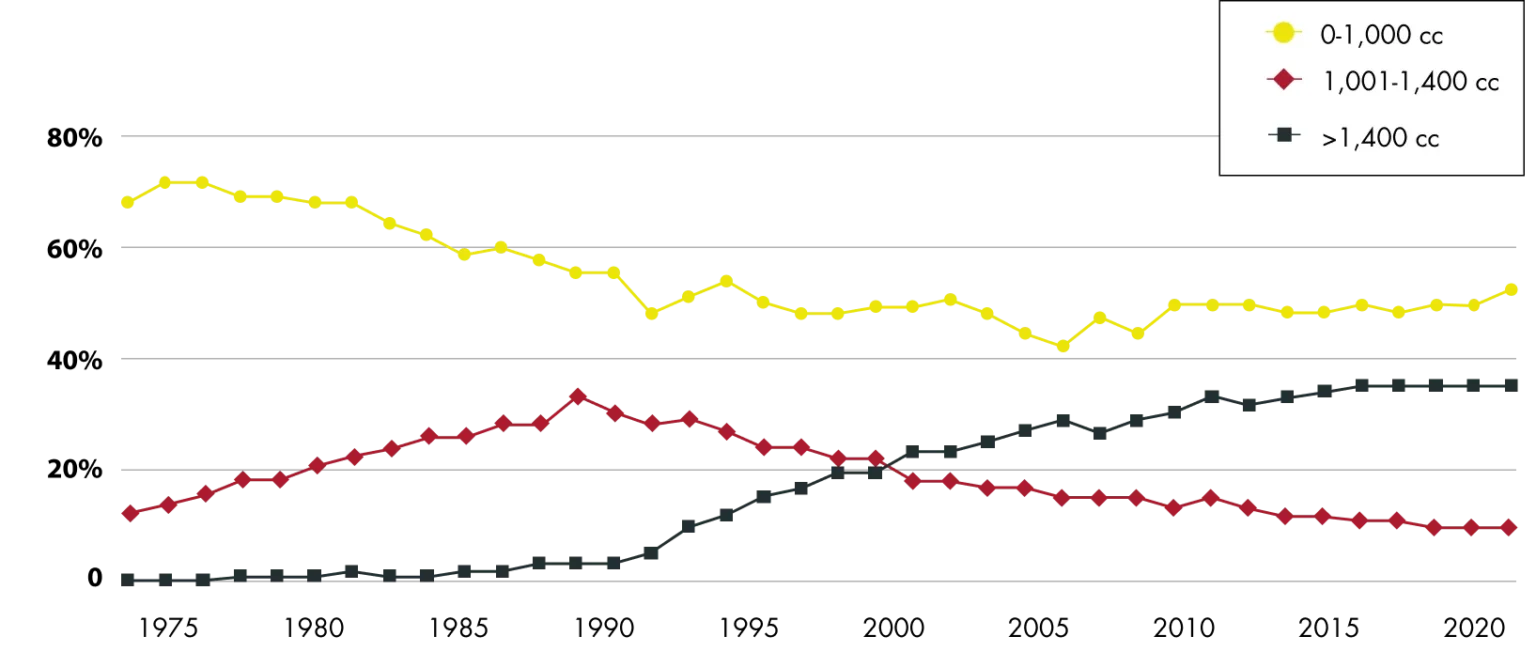
Important Steps for Riders to Take
While some motorcycle accidents are not preventable, riders can take some precautions to avoid more catastrophic crashes. It’s important to practice operating new or unfamiliar motorcycles by riding in a controlled area before taking the bike into traffic, especially in bad weather and around road hazards. When riding, obey traffic lights, signs, speed limits, and lane markings, and always leave room between yourself and other vehicles. Switch lanes safely by checking behind you first and using your turn signal.
Before every ride, ensure your motorcycle is in safe working condition. Check the bike’s tire pressure, tread depth, hand and foot brakes, headlights and signal indicators, and fluid levels. Check under the bike for signs of oil or gas leaks, and secure and balance any cargo you may be carrying. Other steps you can take to ride as safely as possible include:
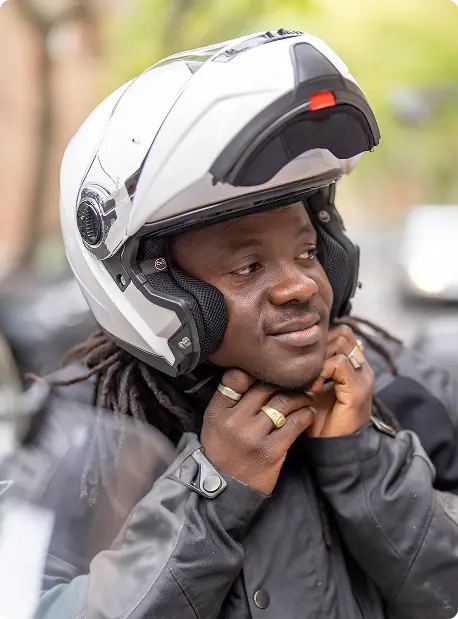
Helmet and Proper Gear Usage
A helmet is the best hope for protecting your brain from injury in a serious motorcycle crash. Studies show that helmets are 37 percent effective in preventing motorcycle deaths and 67 percent effective in preventing brain injuries. Only two-thirds of motorcycle riders nationwide used Department of Transportation-compliant helmets in 2022, and only 42 percent of people killed as motorcycle passengers were wearing helmets.
Helmet use directly influences motorcycle fatality trends, but only 18 states mandate helmet use by all riders. These universal motorcycle helmet laws require all motorcycle riders to wear helmets on public roads, and evidence shows universal helmet laws are associated with lower rates of motorcycle-related injuries and deaths. Helmets are the most effective motorcycle safety measure shown to save lives in crashes, and the universal helmet law has proven to be the best way to ensure helmet use. Motorcyclist fatalities are significantly more common in states with no helmet laws or partial helmet laws.
When riding a motorcycle, you should wear a helmet and completely cover your arms and legs, ideally with leather or heavy denim. Boots or shoes should fully cover your ankles. Gloves and bright, reflective clothing can also protect you and make you more visible to other drivers.

Avoiding Alcohol
Alcohol and drugs negatively affect your judgment, balance, throttle control, and ability to shift gears, as well as impairing alertness and reducing reaction time. Even when you are fully alert, it’s impossible to predict the actions of other vehicles and pedestrians, and being under the influence of alcohol or drugs makes the task even harder. Forty-two percent of motorcycle riders who died in single-vehicle crashes in 2022 were alcohol-impaired.
If you believe you or a loved one has a problem with alcohol consumption and may be a danger to themselves or others, it’s important to seek help as quickly as possible.

Being Cautious
Most multi-vehicle motorcycle crashes result when other drivers don’t see the motorcyclist. Safe riding practices and cooperation from all road users will reduce injuries and fatalities on U.S. roads.
The Skilled Motorcyclist Association—Responsible, Trained, and Educated Riders Inc., or SMARTER, is a motorcycle safety association for people and organizations that care about motorcycle riders’ safety. Its mission is to gather, examine, catalog, and share motorcyclist safety information and research with riders and drivers so every motorist can make responsible decisions on the road.
Mental Health for Motorcyclists
Several studies have shown motorcycle riding can relieve stress and improve riders’ mental health. While riding is important to motorcyclists, it must be done safely and with the proper precautions to avoid life-changing consequences. Many health risks associated with motorcycle riding can be minimized by wearing a helmet, dressing appropriately, driving defensively, and not riding in dangerous weather conditions.
One neurobiological study published in the medical journal Brain Research yielded evidence that motorcycle riding may have mental and physical benefits. While riding, participants experienced increased sensory focus, resilience to distraction, adrenaline levels, and heart rate. They also experienced decreased cortisol, a hormone associated with stress. The study found that riding a motorcycle decreased hormonal biomarkers of stress by 25 percent while providing an endorphin rush and a core workout.
Even though motorcycle riding can come with physical and mental health benefits, the risk of accidents makes safe driving and proper precautions critical. Motorcyclists involved in road accidents have an 80 percent chance of getting injured, as opposed to a 20 percent chance for passenger vehicle occupants.
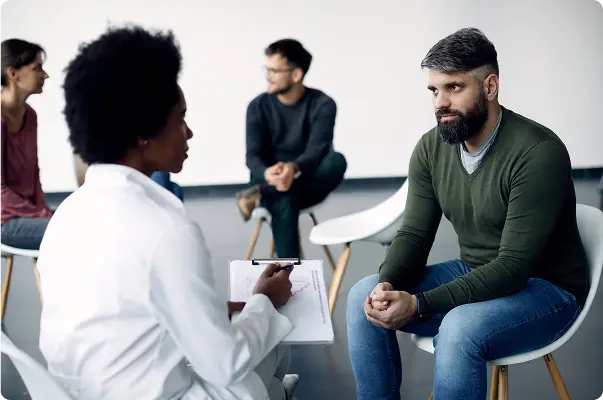
Navigating Mental Health Issues After a Motorcycle Crash
After a motorcycle accident, it’s common for the people involved to have both physical and mental health concerns. Due to the intense nature of motorcycle accidents, it’s important to have a support network and understand common diagnoses like post-traumatic stress disorder and anxiety. Even in the most unavoidable accidents, it’s common to feel anxiety and guilt about what you could’ve done differently. In these moments, seeking support is crucial.
Resources After a Motorcycle Accident
If you are injured in a motorcycle accident, you’ll need support, and you may be in a condition where your loved ones also need support. It’s important to take care of your mental health as well as your physical health. Don’t just assume the issues will go away on their own. Seeking help after an accident is a sign of strength.
Medical Assistance
Not all injuries will manifest immediately after an accident. Even if you don’t think you’ve been severely injured, it’s important to have a thorough exam by a medical professional to ensure there are no hidden injuries or brain trauma.
Immediately after an accident, call 911 to be evaluated by EMTs and ensure a police report is filed. You should also consider seeking mental health support for any trauma you may have experienced emotionally in the crash; many victims of serious crashes develop PTSD.
Support Groups
Support groups with other motorcyclists who have been injured in accidents can provide critical emotional support to riders dealing with the aftermath of a crash. Nonprofit organizations like BikerDown assist motorcycle accident victims with emotional support, medical equipment, and financial advice, aiming to minimize losses for riders and their families. You may also find trauma victims’ support groups helpful for developing coping mechanisms and processing your grief.
Legal Assistance
If you or a loved one has been injured in a motorcycle accident caused by someone else, you may be entitled to file a personal injury lawsuit and seek compensation for your injuries and other losses. A motorcycle accident attorney can pursue the compensation and justice you deserve.
The Illinois Hammer Injury Attorneys have more than 30 years of injury law experience in Illinois and have recovered more than $500 million for our clients across the state. We will help you get the treatment you need to heal while taking care of all the legal details, giving you one less thing to worry about.
Contact us today for a free consultation by calling 888-742-6637 or filling out our online contact form.
